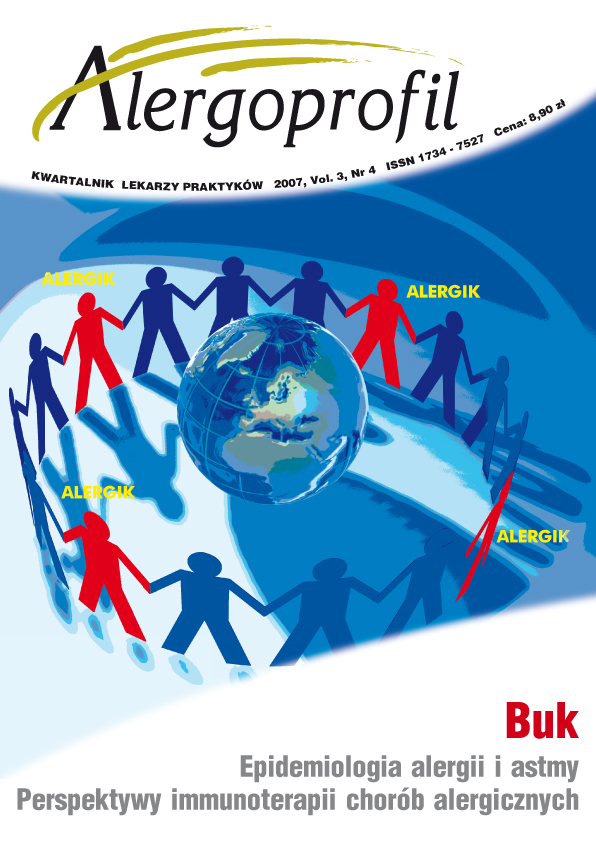The hazel pollen allergens
Main Article Content
Abstract
Hazel pollen season in Poland usually starts between the end of January till the beginning of March and lasts till the end of Marchdepending on the region. Hazel pollen count reaches moderate and high levels. The authors present current state of knowledge regarding hazelpollen allergens and discuss their significance in allergic rhinitis and Oral Allergy Syndrome
Downloads
Article Details
Copyright: © Medical Education sp. z o.o. This is an Open Access article distributed under the terms of the Attribution-NonCommercial 4.0 International (CC BY-NC 4.0). License (https://creativecommons.org/licenses/by-nc/4.0/), allowing third parties to copy and redistribute the material in any medium or format and to remix, transform, and build upon the material, provided the original work is properly cited and states its license.
Address reprint requests to: Medical Education, Marcin Kuźma (marcin.kuzma@mededu.pl)
References
2. Rapiejko P., Lipiec A., Modrzyński M., Chłopek K., Jurkiewicz D.: Analiza stężenia pyłku drzew w 2003 roku. Alergia 2004; 19 (1): 7-12.
3. Seneta W., Dolatowski J.: Dendrologia. PWN, Warszawa 2004.
4. Szafer W., Kulczyński S., Pawłowski B.: Rośliny polskie. Cz. I. PWN, Warszawa 1988.
5. Puc M.: Pyłek wybranych taksonów roślin w powietrzu Szczecina, 2001-2005. W: Pyłek roślin w aeroplanktonie różnych regionów Polski, Weryszko-Chmielewska E. (red.). AM, Lublin 2006.
6. Weryszko-Chmielewska E., Piotrowska K.: Pyłek wybranych taksonów roślin w powietrzu Lublina w latach 2001-2005. W: Pyłek roślin w aeroplanktonie różnych regionów Polski, Weryszko-Chmielewska E. (red.). AM, Lublin 2006.
7. Puc M., Weryszko-Chmielewska E., Malkiewicz M., Myszkowska D., Piotrowska K. et al.: Pyłek leszczyny w powietrzu wybranych miast Polski w 2005r. Alergoprofil 2006; 2,1: 40-44.
8. Malkiewicz M., Weryszko-Chmielewska E., Myszkowska D., Piotrowska K., Tarasewicz A. et al.: Analiza stężenia pyłku leszczyny w wybranych miastach Polski w 2006 r. Alergoprofil 2006; 2,2: 31-36.
9. Piotrowska K.: Ekologiczne cechy kwiatów oraz obfitość pylenia Corylus avellana L. I Alnus glutinosa L. Gaertn. Mat. XXXIX Nauk. Konf. Pszczel. Puławy 12-13 marca 2002; 77-79.
10. Weryszko-Chmielewska E., Piotrowska K.: Cechy ekologiczne kwiatów roślin wiatropylnych. W: Weryszko-Chmielewska E. (red.): Pyłek roślin w aeroplanktonie różnych regionów Polski. AM, Lublin 2006.
11. Piotrowska K., Weryszko-Chmielewska E., Rapiejko P., Puc M., Malkiewicz M.: Analiza stężenia pyłku leszczyny w wybranych miastach Polski w 2007 r. Alergoprofil 2007; 2 (w druku).
12. Mehlenbacher S.A., Brown R.N., Nouhra E.R. et al.: A genetic linkage map for hazelnut (Corylus avellana L.) based on RAPD and SSR markers. Genome. 2006; 49(2):122-33.
13. Rapiejko P., Lipiec A., Emeryk A., Bartkowiak-Emeryk M.M., Bartuzi Z. et al.: Annula total amount of pollen and frequency of positive skin pick test results to pollen allergens. Polish. J. Environ. Stud. 2006, 15 (2a): 653-660.
14. Rapiejko P., Stankiewicz W., Szczygielski K., Jurkiewicz D.: Progowe stężenie pyłku roślin niezbędne do wywołania objawów alergicznych. Otolaryngol. Pol. 2007, 61(4): (w druku).
15. Luettkopf D., Mueller U., Skov PS., Ballmer-Weber BK., Wutrich B., et al.: Comparision of four variants of a major allergen in hazelnut (Corylus avellana) Cor a 1.04 with the major hazel pollen allergen Cor a 1.01. Mol Immunol 2001;38:515-525.
16. Roux K.H., Teuber S.S., Sathe S.K.: Tree nut allergens. Int Arch Allergy Immunol 2003; 131:234-244.

